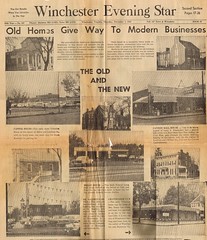We often talk about our successes at PHW, but it’s important to remember that not every project or property we’ve set our sights on was able to be saved through our efforts. Here are a few “big fish” stories from 1963 to the early 1970s which did not bear fruit.
 Some of the demolished properties which initially concerned the nucleus of PHW in 1963 included Dr. Baldwin’s stone office and the Cannon Ball House on South Loudoun Street, the Capper House on North Loudoun Street, the Chanticleer Inn on West Boscawen Street, and the Hollis House on Cork Street. It appears that these properties were used as examples in the November 1963 meeting at the Handley Library, mentioned in passing in the January 24 post.
Some of the demolished properties which initially concerned the nucleus of PHW in 1963 included Dr. Baldwin’s stone office and the Cannon Ball House on South Loudoun Street, the Capper House on North Loudoun Street, the Chanticleer Inn on West Boscawen Street, and the Hollis House on Cork Street. It appears that these properties were used as examples in the November 1963 meeting at the Handley Library, mentioned in passing in the January 24 post.
Concurrent with the Conrad House, several other buildings were part of the public discussion on parking lots downtown. This included the old health building, the Firestone Building, and Valley Distributors at Braddock and Amherst Streets. The properties were consolidated by the Winchester Parking Authority and razed in 1966-1968, eventually becoming the Braddock Street Parking garage. PHW spoke out in particular for the old health building, even attempting the lease the building to prevent its demolition.(1)(2)(3)(4)
 Toward the end of the battle for the Conrad House, Hawthorn on Amherst Street was similarly being threatened with demolition for subdivisions for more Whittier Acres construction if the building could not be sold. Although PHW toyed with the idea of buying the property jointly with other civic organizations, the idea did not come to pass and the home was preserved through private efforts. Conrad House enthusiasts may be pleased to note the front porch now on Hawthorn was salvaged from the Conrad House.
Toward the end of the battle for the Conrad House, Hawthorn on Amherst Street was similarly being threatened with demolition for subdivisions for more Whittier Acres construction if the building could not be sold. Although PHW toyed with the idea of buying the property jointly with other civic organizations, the idea did not come to pass and the home was preserved through private efforts. Conrad House enthusiasts may be pleased to note the front porch now on Hawthorn was salvaged from the Conrad House.
Following the demolition of the Conrad House, efforts were made to purchase the small stone building then at 8 East Cork Street, often referred to as Friendship Market. That building, as well as several others, was for sale as part of the Sirbaugh Estate. However, the sellers had no desire to split up the package of properties and sell the stone building separately. PHW still managed to have a hand in that building’s preservation, which we will cover in a later post.(5)(6)
Also considered for purchase was the stone building at 15 South Braddock Street, as its location was no longer suitable for a dwelling and it could be adapted for office use.(7) Houses on Sharp Street were circled several times as being of interest to restore to provide more low-cost housing in the city and to retain for their historical and architectural value.(8) Properties on South Loudoun were also seen as potential purchases for similar restoration efforts. Word reached PHW about a possible City-led demolition of a log house at 502 1/2 South Cameron Street. None of the gentle inquiries or outright offers about purchasing these properties bore fruit.
Next week, however, we will learn how PHW became motivated to start a revolving fund and become serious about purchasing endangered properties.